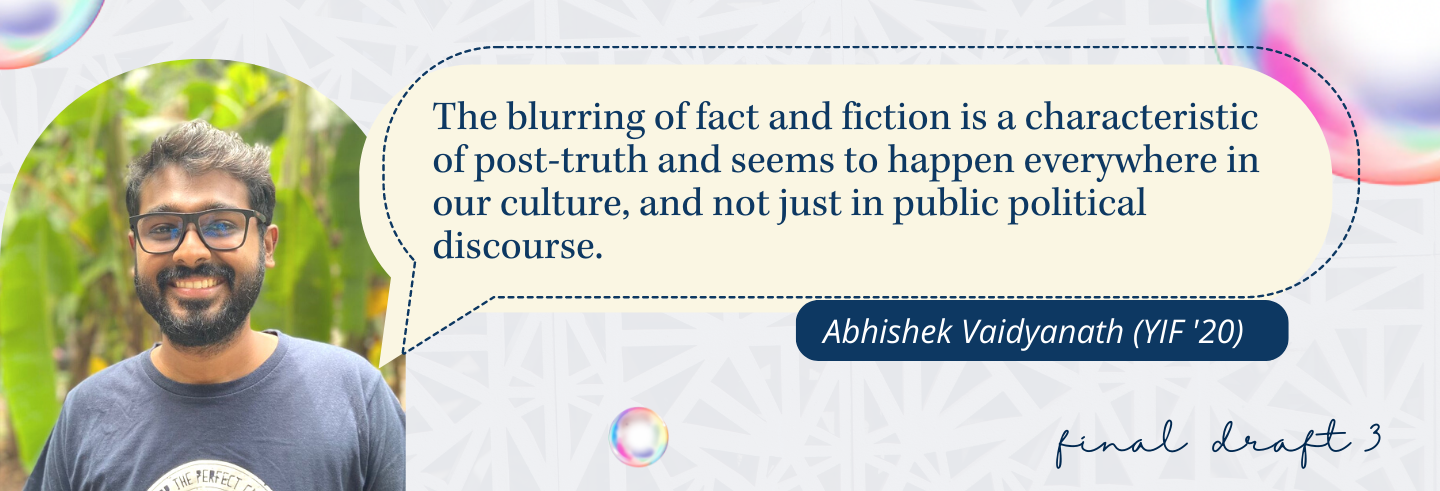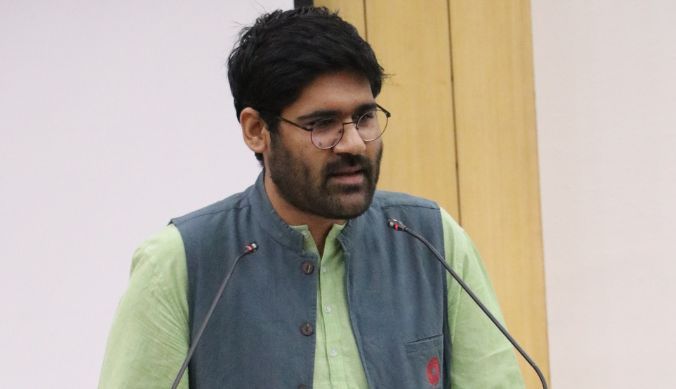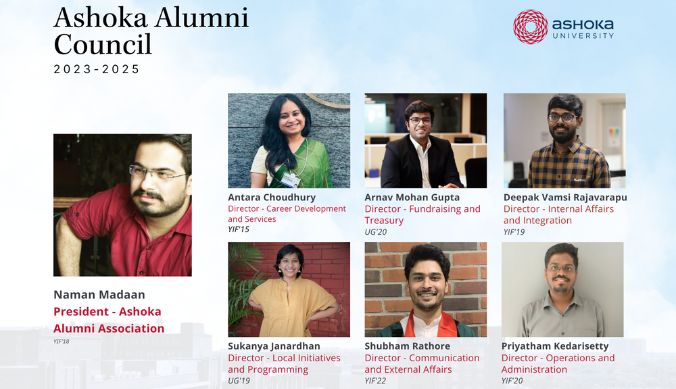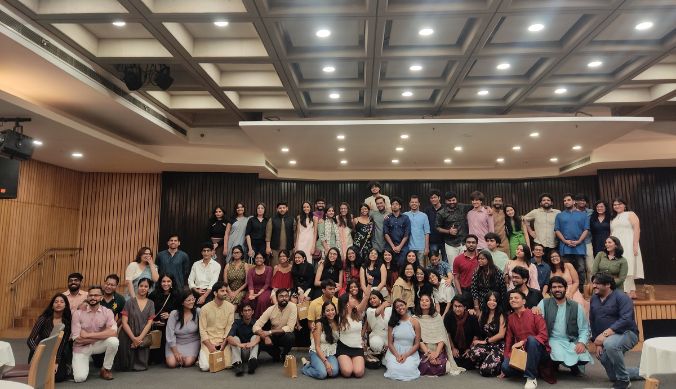‘This is Not a Paper: A Meta-Paper on Metafiction in a Post-Truth World’
Featuring Abhishek Vaidyanath’s creative piece that developed as an original project over his term at the Young India Fellowship
Abstract:
A fresh approach and an experimental form is what sustains this paper on Meta-modernism and meta-fiction; it has novelty in both form and content; uses a movie called buddha.mov among other texts to draw out tropes of postmodernism and posits meta-modernism as a possible way out of some of postmodernism’s dead-ends.
Article:
Introduction
I was recently watching a show called Aspirants; the show is about the lives of UPSC aspirants preparing for the exam in the hub, Old Rajinder Nagar, Delhi. In one scene, after the protagonist was accused of having a ‘confused shakal’, he replies, “We are living in a postmodern society, we tend to be confused, bas main thoda zyada confused hu” (UPSC 33:40). While a direct causation between postmodern thought and people being confused is an oversimplification, the connection does seem apparent to a lot of us. Another phrase that the protagonist could have used, though not very common, is that “we live in a post-truth world”. Now here, it’s much easier to make sense of the confusion, as the truth itself is qualified by ‘post’; whether it’s the lack of truth, or existence of multiple truths, is something that I want to explore in this paper.
Postmodern thought has been around for more than a century (McIntyre, 6), and there is a sea of literature on it. For this paper, I will take the help of one of those postmodern literary ideas that I personally find exciting. It’s the idea of the ‘meta’. Many of us use this word to describe a wide range of thoughts and situations. I’ll use some movies, and this paper itself, to try and emulate the concept of ‘meta’ and what it has to do with postmodernism and post-truth. Thus, I will use this meta-paper to first elucidate what metafiction looks like, and then argue that while postmodernist tendencies largely cause post-truth, there are some redeemable qualities that can be observed in metafiction that can even help navigate post-truth.
Chapter 1- Post-Truth: not just fake news
Post-truth—The Oxford Dictionary Word of the Year 20161, rose to fame during the rise of Trump and his famous and outright denials of facts during his campaigns. Thus, the early understanding of the word was that it describes a world where there are no objective facts and truths; people believe in their own versions of facts, to make up their own versions of truths. The Oxford Dictionary defines post-truth as, “relating to or denoting circumstances in which objective facts are less influential in shaping public opinion than appeals to emotion and personal belief”. Lee McIntyre, in his book Post-Truth, while talking about the origins of this term, says that, “post-truth amounts to a form of ideological supremacy, whereby its practitioners are trying to compel someone to believe in something whether there is good evidence for it or not” (13). There is a lot to unpack here, but what stands out is ideology, and appealing to emotions rather than evidence. How are these emotions delivered? Stories, narratives, and fiction. Now, what is also to be noted, is that these narratives aren’t devoid of objectivity. At least, at the outset. An ideologue would still state facts, and truth, but woven in a way into the narrative, that furthers their agendas.
The blurring of fact and fiction is a characteristic of post-truth and seems to happen everywhere in our culture, and not just in public political discourse. Yuval Noah Harari in an excerpt from his book 21 Lessons for the 21st Century, in the article “Are We Living in a PostTruth Era? Yes, But That’s Because We’re a Post-Truth Species” says: “Blurring the line between fiction and reality can be done for many purposes, starting with ‘having fun’ and going all the way to ‘survival.’” He talks about how we ‘suspend disbelief’ while watching or playing a game, reading a novel or watching movies. We know that it is just fiction, and make-believe, but we still choose to enjoy it, often deeply and sincerely. While this is the ‘having fun’ part of his quote, the ‘survival’ part comes when we not only believe, but sometimes dedicate our whole lives to fictions like money and the idea of Nation. He says that we have “the remarkable ability to know and not know at the same time” (Harari). We all thus have shared fictions that are such integral parts of our lives that we sometimes forget the fictionality of it. This is one of the glaring symptoms of post-truth, and shades of these are seen in postmodern thought as well.
Day 2- Postmodernism: what did you do?!
It’s the third day of writing this paper, and I only have these phenomena and words in my head. Let me go back to McIntyre and find some connections there. I hope these musings in my journal lead to some connection or idea popping up. Aha! There was an entire chapter called “Did PostModernism Lead to Post-Truth?”
He, while taking us through various understandings of postmodernism, says: “The postmodernist approach is one in which everything is questioned and little is taken at face value. There is no right answer, only narrative” (125). Rings a bell? When everything we read, or watch, is reduced to a narrative, and is questioned, it means that it is up for deconstruction. Friedrich Nietzsche, who came even before we talked about postmodernism, says, “There are no facts, only interpretations.”2 For Nietzsche then, the world already looked like one that is devoid of truth; it was only a matter of time that we started seeing it too.
I can say this because I played Nietzsche in a college play. I was given a script, and as it was a satirical play, I thought that the dialogues were made up and changed. But now I was reading about postmodernism, I realised that this was something that Nietzsche actually wrote and believed. I was indeed being true to Nietzsche. But what about the audience? Would those who hadn’t read Nietzsche have thought that I was saying something that he actually said? Or will they, like me, think that it’s just fiction, and truth doesn’t matter, in this context of watching a play for fun? Here, what is actually at play is a manifestation of irony. While what I said was true, in some sense, I said it ironically, to garner laughs. This irony had a few layers: first was the fact that I am not Nietzsche; second that the context of the play was satirical and a criticism of those who blindly quote and follow such great thinkers and think of themselves as great thinkers too. This kind of irony which we see not only in plays, but everywhere these days, invites again, a kind of deconstruction and subjectivity with which the source can be read for intended meaning, and what the audience ultimately would like to interpret. The layers of irony puts the audience at a distance where the truth is subverted as there is a gap between what is said and what is meant.
But this subversion of the truth goes too far when instances of irony and other postmodern literary devices become more commonplace. In the video essay “David Foster Wallace—The Problem with Irony” by Will Schoder, David Foster Wallace says, “The problem is that now a lot of the shticks of postmodernism—irony, cynicism, irreverence—are now part of whatever it is that’s enervating in the culture itself.” Wallace was talking about American TV in the ‘90s and how most of the shows had become more ‘self-referential’, which gave rise to cynicism and irony. Referencing itself, or critiquing itself, meant that we could no longer criticise it, as the show, movie or content has done that for us, and in the process not only rendered itself, but also rendered other content of this kind, meaningless. Wallace believed that this resulted in us not taking anything seriously after a point because there was no element of sincere engagement left as the culture itself was getting too cynical and ironic (Schoder). An increase in this kind of ‘irreverence’ would devalue truth and the search for truth. Every fact or instance of objectivity will be seen with this culturally acquired lens of cynicism and aggravate the sense of post-truth. Wallace thus believed that “postmodernism has to a large extent run its course” (Schoder).
In the previous chapter, the lens with which we tried to understand some symptoms of post-truth, was fact and fiction. Here, we went further into some manifestations of exactly the kind of fiction that amplifies our perception of reality. This self-referential, ironic, and often cynical content, can be associated most closely with metafictional content.
Scene 3—Enter metafiction: how meta can it get?
Let me take a break from this paper or whatever I am writing, and go back to the time and instance that actually inspired me to write on this idea; I am also hoping that this anecdotal reasoning would add depth to my argument. This is when I had just watched a film called BUDDHA. mov, by Kabir Mehta that came out in 2017, knowing it would have something interesting to say as it did some rounds in film festivals and won some accolades. It was a very postmodern film with extreme self-referentiality, which also makes it a metafictional film. What makes it meta is the reference and acknowledgement to itself being a film within the content of the film. I had to tell this to my friend as my brain was making connections from meta-films, to postmodernism, to post-truth. We had a phone conversation that day, and it went like this:
FRIEND: Okay, okay, calm down. And tell me why you think this movie is so meta and postmodern?
I: So dude, on the movie cover page, the genre was mentioned as Documentary. So I was expecting a real-life story of this guy, Buddhadev. But then, just a few minutes into the movie, Buddhadev is with this woman in a hotel room getting intimate and both of them displaying full nudity. This is where things started getting shady. Documentaries, especially biographies, never go to the lengths of showing someone’s most private moments happening inside a hotel room. This is when I realised that there has to be some fictionalisation involved. When the cast rolled out at the end, I realised I was right and all the women were in fact actors with their names hidden.
FRIEND: So why isn’t it like any other fictional movie?
I: Because in the scene after this, Buddhadev was looking himself up on Google. His page showed up, and this is how they show us that he is a first-class cricketer from Goa. All his bowling statistics were on this page, along with his Wikipedia! I pick up my phone immediately and do the same Google search to find that it is indeed true. The guy was Buddhadev himself, and I was seeing his story on screen. He was himself, but also playing himself. Nonfiction and fiction coming together!
FRIEND: So are you saying that this blurring of lines between fiction and non-fiction makes us question whether what is happening on-screen is the truth and the reality? And how does the meta-ness come in here?
I: Yes, that’s right. The film goes into meta territory when Buddhadev is talking to the film-maker, Kabir Mehta himself. We see chats between Buddha and Kabir, where Buddha is giving him ideas on what all he can add to the film. They are basically talking about this film, in the film. In another scene Buddha even acknowledges that Kabir wanted to add fictional elements in the film, after which Buddha starts narrating fake incidents that can be added. They were continuously going meta by talking about the process of making the film. But the next scene is when the post-truth aspect of meta-ness hits. Kabir and Buddha are filming Buddha’s gardener. The camera movement is handheld and raw. We hear Kabir telling Buddha: “This is amazing, festivals love this class shit.” Now this scene said a lot. It was a commentary on how documentary film-makers, too, come with their own biases, ideologies, perspectives, and subjectivity. They often show what they want to convince the audience of their own beliefs by hiding them under the veil of documenting truth. It was as if Kabir was debunking the claim to truth through non-fictions.
This was a perfect use of irony and postmodernism to do this. In the words of David Foster Wallace, “Exploiting gaps between what’s said and what’s meant, between how things try to appear and how they really are—is the time-honoured way artists seek to illuminate and explode hypocrisy” (Schoder). Kabir was thus exposing this hypocrisy of manipulating the truth, while claiming to be true, by doing it to himself, which adds to the credibility as he isn’t just passing an opinion about others. It was as if Kabir Mehta was screaming to me that all documentary film-makers are liars!
FRIEND: Wow! This connection is interesting between metafiction and post-truth because of postmodernism. But, are you saying that metafiction is causing post-truth, or is it telling us what post-truth looks like? Why don’t you use Marie-Laure Ryan’s reading to talk more about this?
I: How do you know that I have read this?! I never told anyone about that.
FRIEND: Ha ha ha! Oh, you sweet innocent child. How can I not know? Did you forget again?
I AM YOU
Section 4- Metafiction and Post-Truth
After that small meta experience in life, I want to situate where metafiction lies between fiction and non-fiction, and what further implications it has on our perception of truth and reality. When the distinction between fiction and non-fiction seems to dissolve, it makes it difficult for us to discern the truth, by making it harder to weigh the different narratives against each other. Marie-Laure Ryan in her paper “Postmodernism and the Doctrine of Panfictionality”, while taking a position for maintaining the distinction between fiction and non-fiction says:
The distinction between fiction and nonfiction is important as it provides our only protection against the “hyperreality syndrome” (to borrow Baudrillard’s concept): the replacement of reality (or the masking of its absence) by the simulacra thrown at us by culture and the media. If all representations produce their referent, they are all equally true, and we are doomed to fall under their spell. Under this regime, different images cannot be compared in terms of their relative truthfulness, since truth is a relation, and comparing this relation pre supposes a common external referent. (180)
Non-fiction by convention is supposed to have a reference in the real world. This reference, by virtue of being the real world, makes it possible for us to verify facts, and also compare the realities that they present with each other and come to an inference on our own. But when the distinction isn’t maintained, when everything is seen as fiction, they all have their own referent, that may or may not be the real world. In simple terms, they all have their own context, in which all of them are true. When a ‘common external referent’ is thus missing in this case, we cannot get to the truth ‘since truth is a relation’. This eventually leads to a situation where we end up mistaking reality for whatever reality the popular media and culture sells us. Ryan argues that a distinction between the two will thus save us from this ‘hyperreality syndrome’, and we will no longer be ‘gullible victims’ of fabrications, as when there is no fictionalisation, we can see for ourselves and choose for ourselves between the different realities, but with a common reference, i.e., this world (180). To give an example, we can compare and verify what two documentaries or what two different news channels are saying about some event, and choose for ourselves which one is closer to the truth, as both of them refer to the same world. But imagine a scenario when news channels decide to show a fictionalised depiction of what happened. We would now not be able to compare the two realities as they have their own made-up reference worlds, and remain equally true in their own context.
My above example about the metafictional BUDDHA.mov would now seem like it is adding to the post-truth by doing exactly the above—erasing the distinction between the two. But that isn’t the case. What metafiction actually does is to carve a different third genre of its own, which helps us navigate the problems that post-truth presents. Ryan, while talking about how metafiction, through ‘inversion’ of the qualities of both of these, invents its own position, says, “Metafiction tends toward the abdication of both the guarantee of truth and the illusion of a reference world” (182). She says that metafiction works in a way that it does not ‘guarantee’ its own make-believe truth, and it also does not claim to be true because of its reference to the real world. We have many times seen how fictions can contribute to posttruth, but how non-fiction does it, is more subtle. Verification of facts is not always possible, so the claim to truth of non-fictions becomes automatically problematic and also a proponent of post-truth. In BUDDHA.mov, this works in a way that when we start getting into the fictional world of Buddha, he starts talking to the director, self-references to the film, and as a result, pushes us out of this world. Then, when we think that it’s the director making a film on Buddha in the real world, they start throwing in fictional elements and remind us that what we are watching is not real. To put it briefly, metafiction is moving away from the post-truth elements of both fiction and non-fiction.
Another way in which metafiction helps in navigating post-truth is by asking us to stay at a critical distance. While explaining what metafictions are, Ryan says: “Excluded from the fictional world through the visibility of the medium, the reader of self-referential fiction contemplates this world from a foreign perspective, through which he remains anchored in his native reality” (169). This foreign perspective keeps us grounded in our own reality, and we remain at a critical distance from the film, which is useful in my opinion to discern and stay in touch with the truth. Thinking critically itself is about not taking anything at face value, close reading, analysing, and then forming an informed opinion or judgement about the same. Like in BUDDHA.mov, metafiction, by keeping us at a critical distance, can help us see how there can be biases and intentions of non-fiction film-makers who would want us to believe what they believe.
But when we consider the experience of watching a film, critical distance doesn’t sit well with it. We want to feel engaged in the movie, and want to root for the protagonist. This insincere watching of a movie is what Wallace disliked. He predicted the damage irony would do. I left it at this in the previous chapter, but Wallace did give us a ray of hope, a solution of sorts.
Journal entry 5- Metamodern sincerity for navigating post-truth
I sat there wondering how to end this paper on a hopeful note after all the dark and scary thoughts about post-truth and losing touch with reality. In the same way that the Communist Manifesto was born when society was ridden with capitalism, it is the “Metamodernist Manifesto” by Luke Turner, that seems to hold some answers to how we can navigate postmodernism and in turn post-truth as well. The eighth and the last statement of this manifesto is: “Thus, metamodernism shall be defined as the mercurial condition between and beyond irony and sincerity, naivety and knowingness, relativism and truth, optimism and doubt, in pursuit of a plurality of disparate and elusive horizons. We must go forth and oscillate!” (Turner). Let’s go through this one by one.
What is the sincerity in the above definition? In the same video essay, Will Schoder presents the solution to this problem of postmodernism that Wallace proposes—New Sincerity. This new sincerity is a shift in content to move away from postmodern tropes of irony and cynicism, to empathetic human stories. No complexities about storytelling, self-referentiality or moral relativism, just stories of human connectedness, resilience, redemption, and ultimately love. But is it possible for us dwellers of the post-truth era to enjoy something sincerely any more? Most of us are so used to postmodern content in popular culture that we almost always tend to deconstruct things: take memes, for example, and how they mostly use ironic or dark humour. This is where the ‘New’ part of New Sincerity comes in. It understands these problems. It will be in a state of ‘oscillation’ or flux between postmodern and modern which enables a more effective delivery of sincerity. This effective delivery comes from the fact that when there is an acknowledgement of postmodern ideas, the audience is engaged and satisfied as this is what they are used to. So when sincerity is delivered after the audience is engaged, it is more effective.
BUDDHA.mov’s ending would be an apt example here. After all the metaness that was displayed in the movie, it tried to end on a sincere note. Buddhadev was now retiring from cricket and moving away from his old habits of being a playboy. We see him working hard in his new venture as a real estate agent, and at the end he is seen eating an inexpensive meal at a local food joint, whereas before this he was always shown hanging out in plush pubs and hotels. The whole character arc of Buddha is thus created, and at the end we see him getting redeemed, as a take-away for the audience. Other examples would be from the video essay itself, where he says how Bojack Horseman, which was ironic at the beginning, later turned into a sincere depiction of loneliness, depression, and existential crisis. The postmodernist irony and humour was used in the beginning for engagement, and then moved on to telling a more empathetic story sincerely. This is metamodern sincerity.
The oscillation is an important idea in metamodernism. The rest of the statement follows from the oscillation between irony and sincerity to other important ideas in flux that are relevant to fighting and navigating post-truth. Like the oscillation between ‘relativism and truth’, and ‘optimism’ and ‘doubt’ (Turner). Metamodernism is thus characterised by this ever-dynamic back and forth between construction and deconstruction, objectivity and subjectivity, hope and cynicism. So when culture moves towards post-truth-inducing qualities, the redeeming qualities bring it back. This process happens continuously and dynamically in the metamodern age, helping us navigate some of the aspects of post-truth.
In the chapter “Fighting Post-Truth,” Lee McIntyre’s closing words are: “It is our decision how we will react to a world in which someone is trying to pull the wool over our eyes. Truth still matters, as it always has. Whether we realize this in time is up to us” (172). So when the post-truth world tries to pull the wool of relativism, doubt or irony over our eyes, we must retaliate with truth, optimism, and good old (new) sincerity.
Simply put, postmodernism has been a teacher. We learnt to think about the world critically, albeit with a little cynicism, and irony. Even though it paved the way for post-truth, making it hard for us to discern the truth and reality, we created art, cinema, and literature that helped us remember that in the end, what matters is sincere connection, with both, the content that we consume, and the people in our lives.
Epilogue
This meta-paper was an attempt to not only present my arguments, and write about post-truth and postmodernism, but also for this paper to be an exhibit of this culture itself. While writing the paper, I was often drawn to the immense scope and directions I could take at every turn, like the mediasphere and the social media element of post-truth, or the linguistic and semiotic aspects of postmodernism, and the theoretical understanding of fictional and nonfictional narrative. Delving deeper into these aspects and combining them with behavioural studies and primary research would form a comprehensive future scope for this study, and more meta-writing could be good content for a book; or should we call it a novel? A metafiction novel. But I am not saying that we need more metafictional works in this world, as it would invoke the ghost of postmodernism, and only add to the feeling of post-truth. I am saying that we need just enough, to keep it metamodern, so that it keeps us aware of post-truth, tells us that truth matters, and helps us find sincerity in our stories.
About the Author:
My writing journey started a while after my journey with cinema did. Like every lover of the movies, I too wanted to make films, write scripts. So, I decided to not pursue engineering any more, and try my hand at something more creative; documentary film was my first choice. Fast-forward to a year later—the interviewer is reading a script I wrote. He then looks at me, smiles, and says, “Welcome to the YIF.” Ok, that didn’t happen the way I described, but a few months later, I was in the Critical Writing class at the YIF. Here is where I unlearned about “writing” and was introduced to a world of language, rhetoric and culture. Post the YIF, I am now treading the waters in Ed-Tech. Both “Ed” and “Tech” have seen massive effects due to the pandemic, and I often find myself revisiting the ideas of critical writing and thinking, and applying them to solve new and exciting problems in my field.
About YIF CW Programme:
The YIF Critical Writing programme is a unique, one of a kind opportunity for Fellows to hone their critical thinking and writing skills under the able supervision of trained experts in the field. The CW programme employs a constantly evolving pedagogy, making learning and knowledge production more collaborative and dialogic. Preceptors at the YIF CW programme teach writing through a range of topics including but not limited to ‘History, Philosophy, and Anthropology of Science’, ‘Politics of Language and Multilingualism’, and ‘Education, Literacy, and Justice’.
About Final Draft:
The Final Draft is the annual journal of the YIF Critical Writing programme. It showcases the range in topic and genre, as well as the strength of writing in the highly diverse YIF student body. These pieces of writing, submitted by Fellows from various classes of the YIF represent only a small fraction of the variety and range of writing done over the years.
About our campaign:
Through our ‘Final Draft 3’ campaign, we hope to give you a glimpse into some of the styles and voices that have evolved, the concerns and ideas that fellows have explored and the seriousness of their engagement with writing as drafts in motion; searching for meaning and connection, which makes this more of a pedagogic exercise book.
(This piece was first published in the Final Draft, A Journal of the YIF Critical Writing Programme.)













